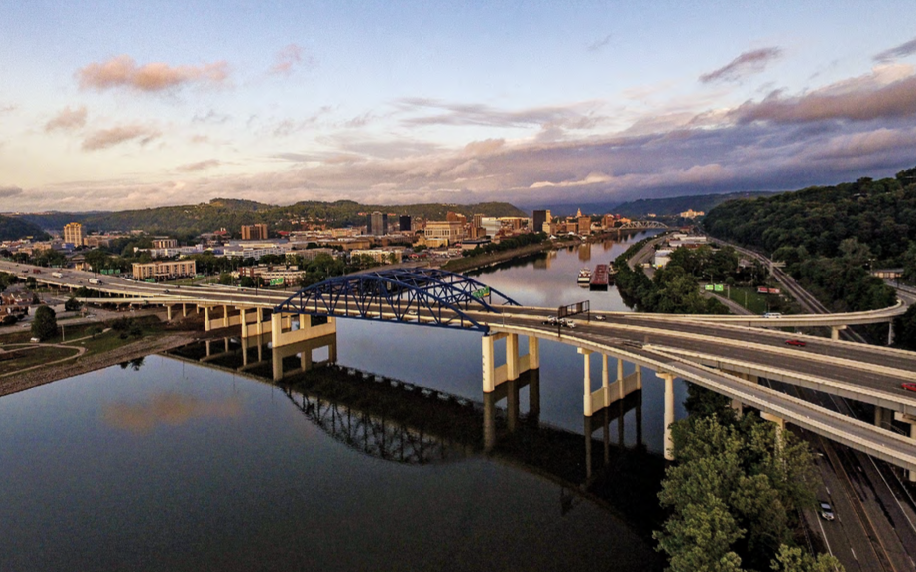By Nathalie De Grandmont
Surrounded by the Appalachian Mountains, the rural state of West Virginia beckons you to reconnect with nature and explore its charming small towns
The first thing that struck us in West Virginia was the astonishing vista of mountains as far as the eye can see. People from what’s known as the Mountain State readily admit it: their state has no major cities. Even the capital, Charleston, has fewer than 50,000 inhabitants. The golden dome of the State Capitol building, on the banks of the Kanawha River, seems lost among the trees. It almost feels as if you’ve been teleported back to pioneer days.
The golden age of the coal mines for which West Virginia has long been known is in the past—many of them are closed down now. Today, the state is focused on the great outdoors. Locals like to boast that nature does things on a grand scale here, and visitors who love fishing, rafting, and hiking in the mountains will be thrilled.
A must-see is the new Waterfall Trail, which includes more than two dozen of the state’s 200-plus waterfalls, starting with Sandstone Falls, the largest, located within the New River Gorge National Park and Preserve. The newest US national park, this gem features plenty of walking paths. The Grandview Main Overlook offers an incredible view of the gorge and its unspoiled natural setting.
Greenbrier Resort
Hot springs abound near White Sulphur Springs, in the southeastern part of the state. If you can visit only one resort here, head for the Greenbrier Resort (formerly The Old White), a tourist destination for more than 200 years and long considered America’s ultimate resort. It has been a favourite with many celebrities and 28 US presidents.
The resort is still popular today—so much so that shuttle buses to the hotel await visitors at the White Sulphur Springs train station. Whether you go by car or choose the train (see box), a stay at the Greenbrier means spoiling yourself in the spa, doing some horseback riding, shopping in its pretty boutiques, playing golf on its prestigious greens, or dining and sampling cocktails in one of 20 restaurants and bars.
Vestiges of times past, the hotel’s lounges and ballrooms, decorated by the famous American interior designer Dorothy Draper in the 1950s, prominently feature rhododendrons, West Virginia’s state flower. So vast that you can take a guided tour (for a fee), the property also includes a chapel and superb gardens, not to mention a thermal pool. It was on this fascinating tour that we learned, among other things, that, the hotel is the site of a secret underground bunker intended to serve as an emergency shelter for the US Congress during the Cold War.
Charming Lewisburg
Driving along the back roads near Greenbrier, we passed orchards and farms—and horses that seemed to be striking a pose for us in the valleys. A few kilometres west of the resort is Lewisburg, a small city founded in 1782. Nicknamed “The Coolest Small Town in America,” it has a friendly retro vibe. Its many historic buildings are well preserved.
High on the list of things to see are the courthouse, Greenbrier College, Old Stone Presbyterian Church (which opened in 1796), and Carnegie Hall, a regional cultural centre that hosts world-class concerts and shows.
The main street teems with appealing businesses: art galleries, specialty food shops, retro boutiques, and antique dealers. The historic General Lewis Inn is filled with antiques. There, you can enjoy local products and creatively prepared cocktails. And like the inn, several lovely restaurants—such as The Stardust Cafe and The French Goat—add to the city’s appeal.
Farm to Table
One of the most rural of the US states, West Virginia is the perfect place to taste local, even hyperlocal, products. Just at the Lewisburg exit, the Hawk Knob Appalachian Hard Cider farm produces renowned ciders and organizes a number of events throughout the year. On our agenda was one of the very popular pairing dinners featuring five ciders and as many dishes inspired by them. We enjoyed a feast of local fish, grilled meats and vegetables, and a decadent dessert, which we ate on the patio at a table with other epicureans, enjoying good conversation, amazing flavours, and a fabulous atmosphere.
Other gourmet discoveries awaited us at the 1010 Bridge restaurant in Charleston. “Here, the Charleston of the South meets the Charleston of the Appalachians,” says chef Paul Smith, a reference to the bourbons that have inspired many of his dishes. He confided that he has a weakness for the salts and salted caramels from J.Q. Dickinson Salt Works, on the outskirts of the city; the on-site shop is popular with tourists. To wrap up our visit, he suggested that we finish our food shopping at Capitol Market, tucked into an old train station. The market is no-fuss, just like the Mountain State. “Almost heaven,” West Virginia’s promotional slogan promises, borrowing from John Denver, and we have to agree.
All Aboard
For a break from the car, try leaving it parked and taking the train that links Charleston to White Sulphur Springs (amtrak.com). The trip, which takes about three-and-a-half hours, offers views of the New River, its canyons, and the impressive New River Gorge Bridge—924 metres (3,030 feet) long and the world’s fifth-longest single-span arch bridge.
To find out more about this destination and plan your itinerary, visit wvtourism.com





